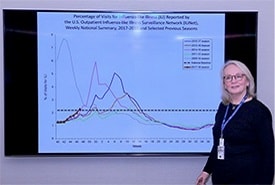Flu Fighter: Lynnette Brammer
Meet flu fighter Lynnette Brammer, lead of CDC’s Domestic Influenza Surveillance team, which is responsible for collecting, analyzing and publishing a weekly report on the impact flu is having across the U.S. This information helps inform efforts to protect the public’s health. The U.S. influenza surveillance system is a collaborative effort between CDC and its many partners in state, local, and territorial health departments, public health and clinical laboratories, vital statistics offices, health care providers, clinics, and emergency departments. Information in five categories is collected from eight different data sources that allows CDC to:
- Find out when and where influenza activity is occurring.
- Track influenza-related illness.
- Determine what influenza viruses are circulating.
- Detect changes in influenza viruses.
- Measure the impact influenza is having on hospitalizations and deaths.
According to Brammer, there is no good flu season, just different degrees of bad.
Name: Lynnette Brammer, MPH
Title: Team Lead of the Domestic Influenza Surveillance team
Location: Atlanta, GA
- What role do you play in fighting flu?
I lead a team that collects, analyzes and reports out data on influenza illness in the U.S. We take a huge amount of data – including from state health departments, public health labs, and health care systems – and compile it into FluView, a weekly surveillance report. This report shows us how the flu season is progressing, the types of flu viruses circulating, the amount of illness and severity of illness, and the geographic spread of flu in the U.S. During flu season people need to know what is going on with flu in a timely manner in order to react and prepare. Our FluView report gives us insight into who may be most impacted by flu viruses during a certain season and how severe illnesses may be during that season. - What is the most rewarding part of your work?
The people I work with. They are the best at what they do and some of the brightest minds in data analytics. My team takes multiple, large data sets from across the country every week and produces a timely and in-depth report that covers everything from what viruses are circulating, how widely they are spreading geographically, and what impact they are having. We are providing timely information that people need to make informed decisions on how to prevent and respond to flu. - What is the most difficult part of your work?
The most difficult part of my work is the pressure to be timely. We have to move fast, and work fast. In the midst of flu season, viruses are spreading and the progression of flu season does not take a break for holidays or weekends. Our work has to match this pace in order to ensure that we are providing the most up-to-date information. We provide a snapshot of the previous week’s flu activity in the U.S. every week. People need this information and they expect it every week. - How serious is flu? What should people know about the risk of flu?
There is no good flu season, just different degrees of bad based on what flu viruses are circulating and how well the flu vaccine is protecting against those circulating viruses. While each flu season is different, what we know by looking at our surveillance reports is the impact and spread of flu that season. Even during the mildest of flu seasons, influenza causes a significant number of hospitalizations and deaths. - What would you say to those who are hesitant to get a flu shot?
A flu vaccine is something you should make time for. You get a vaccine because you don’t want to get the flu, but also because you want to protect your parents or your young child. A flu shot provides an added layer of protection and to me that is a huge reason to get vaccinated each year.



